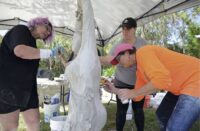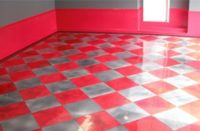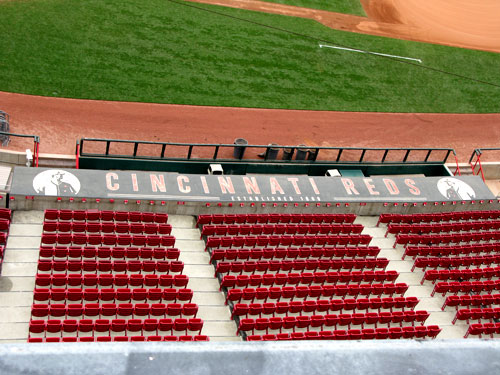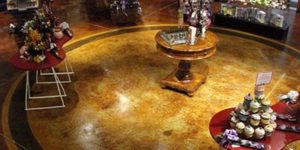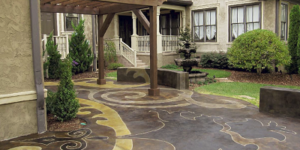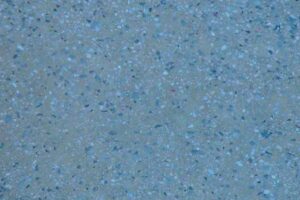When the Cincinnati Reds had to redo two cracked and peeling dugout roofs, they needed a decorative concrete contractor who could not only repair the cracked slabs, but get that Reds red right.
Fortunately, David Stephenson and his company, American Concrete Concepts Inc., are color experts. “We’re really good with color,” says Stephenson. “You want purple concrete, we’re the guys to talk to.”
They were also, evidently, the guys to talk to about red concrete — after some experimentation, Stephenson and his team managed to produce an overlay in the precise shade of the Reds’ logo.
While matching that color was quite a challenge, it was not, by a long shot, the worst obstacle they faced when they were hired to refinish the dugouts at the team’s Great American Ball Park three years ago.
The dugout tops — concrete slabs, roughly 10 feet by 100 feet each — were in bad need of help for a number of reasons. For one thing, they were painted. For another, Cincinnati’s climate is not the most gentle in the country. Between the snow and ice of Ohio winters and the blistering heat of the summers, the paint got a regular beating just from being outside. “It gets real hot in the summer,” says Stephenson. “The paint boils off!”
On top of the weather, there was also foot traffic to contend with. It’s from the dugout roofs that the Reds cheerleading squad stirs up the crowds’ enthusiasm. Stephenson says they will sometimes even let fans cheer on the players from there. Given that the Reds stadium is host to over 150 events a year, that’s a lot of wear and tear.
Aesthetics was not the only problem with the dugout tops. Over the years, the slabs had cracked pretty severely, and during rainier months, the players below were getting dripped on — and they weren’t happy about it.
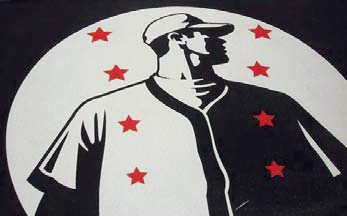 So between the paint bills and their increasingly soggy ballplayers, the Reds management knew they had to do something to address the problem. Finding that solution was up to Doug Gallant, head groundskeeper for the Reds stadium. Gallant knew concrete was still the way to go, but Stephenson says it was up to him to educate Reds staffers on what exactly could be done with it. “All they knew,” says Stephenson, “was concrete was probably more durable than paint.”
So between the paint bills and their increasingly soggy ballplayers, the Reds management knew they had to do something to address the problem. Finding that solution was up to Doug Gallant, head groundskeeper for the Reds stadium. Gallant knew concrete was still the way to go, but Stephenson says it was up to him to educate Reds staffers on what exactly could be done with it. “All they knew,” says Stephenson, “was concrete was probably more durable than paint.”
Before getting the job, Stephenson had to spend some time informing the Reds of their decorative concrete options. “There was a month of basically giving them an education on concrete and what all you can do with it,” he says.
Unfortunately, by the time they were sold on the idea, Stephenson and his crew had only three weeks before spring training started to schedule and complete the work. “They were putting bases on the field,” Stephenson says. “They were ready to play ball as we were starting the job.”
Their time crunch was complicated by the fact that, the week the work was to be done, it rained for four days straight. In an open stadium like the Great American Ball Park, this presented a huge problem for Stephenson and his crew. The steady drizzle during the four days they were working meant they were constantly covering and uncovering the slabs.
“We used tarps and fans and basically babysat the job through,” says Stephenson.
In order to give the dugout a clean surface, as well as stop the leaking, Stephenson used Elite Crete’s Thin-Finish white overlay. But before they could apply it, the existing surface needed some serious work. A new paint job season after season had resulted in many layers of paint that had to be ground away before they’d have a bondable surface. The dugouts may have been built to support dancing cheerleaders, but they would never stand up to enormously heavy walk-behind grinders. Thus, all of the surface prep was done with hand-held angle grinders, wrapped in plastic bags on account of the rain.
Once the overlay was down and set, it came time for the more delicate work. The logos — the Reds logo for the home dugout, and the National League logo for the away team’s — were fairly complex designs. To get the required detail took multiple overlapping vinyl stencils. “They had to be laid out perfectly in an outdoor environment with wind and rain,” says Stephenson. Using batches of Thin-Finish with integral acrylic colorants, Stephenson and his team were able to get the resolution and detail that the Reds were looking for.
On a job like this, accuracy is paramount. “We’re dealing with something that’s going to be on ESPN throughout the year,” Stephenson says. “It took a lot of skill.”
This fall, Stephenson and the ACCI team will be returning to the Great American Ball Park to revisit their handiwork. Not because it’s failing — on the contrary, the only maintenance the dugout tops have required is resealing. But the Reds changed hands in 2006 and the new owners have altered the lettering on the team logo. They wanted the dugouts to reflect the updated design, so they gave Stephenson another call.
“We’ll be back out there to change it up,” says Stephenson, who expects to be starting the work in September, after the baseball season is over. This time, he’s looking forward to having more than three weeks to do the job.
www.acci-us.com
